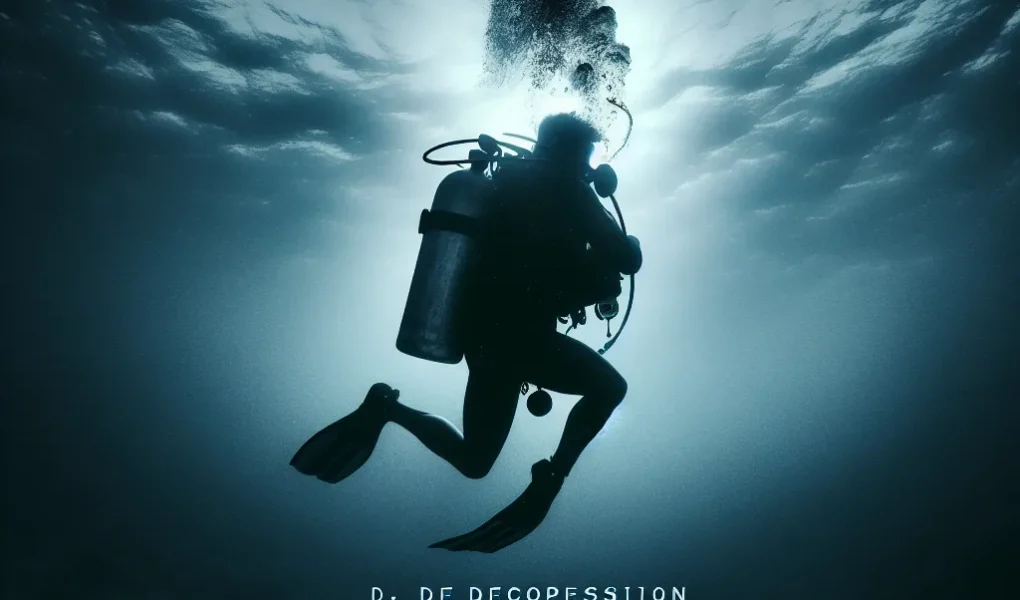Understanding the Risks of Improper Decompression
Proper decompression techniques are crucial for divers and aviation personnel to prevent the risks associated with improper decompression. Understanding these risks is essential for ensuring the safety and well-being of individuals engaging in activities that involve changes in pressure, such as deep-sea diving and aviation.
Improper decompression can lead to the development of decompression sickness, also known as “the bends,” which occurs when nitrogen bubbles form in the bloodstream and tissues due to rapid pressure reduction. The bends can cause symptoms such as joint pain, dizziness, fatigue, and in severe cases, paralysis and even death.
In diving, ascending to the surface too quickly without allowing for proper decompression stops can result in the formation of nitrogen bubbles in the body. Similarly, aviation personnel, especially those involved in high-altitude flights, are also at risk of decompression sickness if the aircraft cabin depressurizes rapidly.
It’s important for divers and aviation personnel to be aware of the risks associated with improper decompression and to adhere to established decompression procedures. This includes following proper ascent rates and allowing for adequate decompression stops to allow the body to safely release accumulated nitrogen.
By understanding the risks of improper decompression and implementing appropriate techniques, divers and aviation personnel can mitigate the dangers associated with rapid pressure changes and ensure their safety during and after their activities.
Remember, proper training and adherence to decompression protocols are essential for preventing decompression sickness and promoting the overall safety of divers and aviation personnel.
Overall, understanding the risks of improper decompression is a critical aspect of ensuring the safety and well-being of individuals engaged in activities involving pressure changes. By prioritizing proper decompression techniques, divers and aviation personnel can minimize the potential dangers associated with rapid pressure reduction and enhance their overall safety.
Proper decompression techniques are crucial for divers and aviation personnel to prevent the risks associated with improper decompression. Understanding these risks is essential for ensuring the safety and well-being of individuals engaging in activities that involve changes in pressure, such as deep-sea diving and aviation. Improper decompression can lead to the development of decompression sickness, also known as “the bends,” which occurs when nitrogen bubbles form in the bloodstream and tissues due to rapid pressure reduction. The bends can cause symptoms such as joint pain, dizziness, fatigue, and in severe cases, paralysis and even death. In diving, ascending to the surface too quickly without allowing for proper decompression stops can result in the formation of nitrogen bubbles in the body. Similarly, aviation personnel, especially those involved in high-altitude flights, are also at risk of decompression sickness if the aircraft cabin depressurizes rapidly. It’s important for divers and aviation personnel to be aware of the risks associated with improper decompression and to adhere to established decompression procedures. This includes following proper ascent rates and allowing for adequate decompression stops to allow the body to safely release accumulated nitrogen. By understanding the risks of improper decompression and implementing appropriate techniques, divers and aviation personnel can mitigate the dangers associated with rapid pressure changes and ensure their safety during and after their activities. Remember, proper training and adherence to decompression protocols are essential for preventing decompression sickness and promoting the overall safety of divers and aviation personnel. Overall, understanding the risks of improper decompression is a critical aspect of ensuring the safety and well-being of individuals engaged in activities involving pressure changes. By prioritizing proper decompression techniques, divers and aviation personnel can minimize the potential dangers associated with rapid pressure reduction and enhance their overall safety.
Factors Affecting Decompression Sickness
Proper decompression techniques are of utmost importance for divers and aviation personnel to prevent the occurrence of decompression sickness. Factors affecting decompression sickness include the rate of ascent, duration of exposure to increased pressure, and the total time spent at depth. These factors directly influence the absorption and release of inert gases, such as nitrogen, in the body tissues.
During ascent, the reduction in pressure causes the dissolved gases in the body to form bubbles. If the ascent is too rapid or the diver has stayed at depth for an extended period, these bubbles can lead to decompression sickness. Additionally, repetitive dives or flights without adequate surface intervals can increase the risk of developing decompression illness due to accumulated nitrogen in the body.
Moreover, individual factors such as age, physical fitness, hydration level, and pre-existing medical conditions can impact a person’s susceptibility to decompression sickness. It is crucial for divers and aviation personnel to be aware of these factors and undergo proper training to minimize the risk of decompression sickness.
In conclusion, understanding the factors affecting decompression sickness is essential for the safety of divers and aviation personnel. By implementing proper decompression techniques and adhering to established guidelines, the risk of decompression sickness can be significantly reduced, promoting safer and more enjoyable diving and flying experiences.
Best Practices for Decompression in Diving
Proper decompression is crucial for divers to prevent decompression sickness, also known as “the bends.” By following best practices for decompression, divers can minimize the risk of this potentially dangerous condition. The most effective way to achieve proper decompression is by following established dive tables or using dive computers to calculate ascent rates and stop times.
One key aspect of best practices for decompression in diving is to ascend at a controlled rate, allowing the body to off-gas safely. Rapid ascents can lead to the buildup of nitrogen bubbles in the bloodstream, which can cause decompression sickness. Additionally, taking regular safety stops at specific depths during ascent allows for gradual off-gassing and reduces the risk of decompression sickness.
It’s also important for divers to monitor their own and their diving partners’ decompression status during and after a dive. This involves using dive computers or tables to track nitrogen uptake and release, as well as discussing any symptoms of decompression sickness that may arise.
Following these best practices for decompression in diving is essential for ensuring the safety and well-being of divers. By minimizing the risk of decompression sickness, divers can continue to enjoy their underwater experiences while prioritizing their health and safety.
In summary, best practices for decompression in diving include controlled ascents, safety stops, and monitoring of nitrogen levels to reduce the risk of decompression sickness. Adhering to these practices is vital for all divers to maintain their health and safety during and after diving activities.
Importance of Decompression Protocol in Aviation
Decompression protocol is of utmost importance in the aviation industry, where pilots, aircrew, and even frequent travelers are exposed to rapid changes in air pressure. Failure to adhere to proper decompression procedures can result in serious health risks, including decompression sickness, commonly known as “the bends.” This condition occurs when nitrogen absorbed by the body under pressure forms bubbles as the pressure decreases, leading to symptoms ranging from joint pain to paralysis and even death.
Following established decompression protocols is crucial for preventing these risks. Aviation personnel must undergo specific training to understand the effects of rapid pressure changes on the body and learn how to mitigate these effects through controlled decompression. Additionally, aircraft cabins are carefully pressurized to maintain a safe and stable internal environment, further emphasizing the significance of proper decompression techniques.
Furthermore, strict adherence to decompression protocol is essential for ensuring the safety of passengers and crew during flights. By following established procedures, aviation personnel can minimize the likelihood of decompression-related incidents and create a secure travel environment.
In conclusion, the importance of decompression protocol in aviation cannot be overstated. It not only safeguards the health and well-being of aviation personnel but also contributes to the overall safety of air travel. Therefore, comprehensive training and strict adherence to decompression procedures are vital components of aviation protocol.
Managing Decompression Risks in High-Altitude Environments
Proper decompression techniques are crucial for divers and aviation personnel, especially when dealing with high-altitude environments. Managing decompression risks in such conditions requires a comprehensive understanding of the potential dangers and effective strategies to mitigate them.
In high-altitude environments, the decrease in atmospheric pressure can lead to decompression sickness, commonly known as “the bends.” This condition occurs when nitrogen, which is breathed in under pressure, forms bubbles in the bloodstream and tissues as pressure decreases during ascent. For aviation personnel and divers alike, this presents a significant risk that must be carefully managed.
One of the key methods for managing decompression risks in high-altitude environments is the implementation of proper ascent and descent rates. This involves regulating the speed at which individuals ascend or descend in order to allow their bodies to adjust gradually to changes in pressure. This reduces the likelihood of nitrogen bubbles forming and causing harm.
Moreover, the use of appropriate decompression tables or algorithms is essential for divers and aviation personnel operating in high-altitude environments. These tools provide guidance on the necessary decompression stops and times based on the depth of the dive or the altitude reached, allowing individuals to safely off-gas excess nitrogen and prevent decompression sickness.
Furthermore, ensuring proper pre-dive or pre-flight assessments and medical evaluations can significantly contribute to managing decompression risks. Identifying any underlying health issues or contraindications for high-altitude operations allows for proactive measures to be taken, reducing the likelihood of adverse decompression-related events.
In conclusion, proper decompression techniques are paramount for divers and aviation personnel operating in high-altitude environments. By carefully managing ascent and descent rates, adhering to decompression tables or algorithms, and conducting thorough medical evaluations, individuals can mitigate the risks associated with decompression sickness and contribute to safer operations in challenging environments.
Training and Preparedness for Proper Decompression Techniques
Training and preparedness for proper decompression techniques are essential for divers and aviation personnel to ensure their safety and well-being. Adequate knowledge and understanding of decompression procedures can significantly reduce the risk of decompression sickness and other related health issues.
Divers and aviation personnel undergo specialized training to learn how to effectively manage and execute proper decompression techniques. This training typically includes theoretical instruction on the physiological effects of pressure changes, as well as practical sessions to simulate real-life decompression scenarios.
Proficiency in using decompression tables, dive computers, and other relevant equipment is also a crucial aspect of the training. Personnel are taught how to interpret and apply the information provided by these tools to make informed decisions during ascent and descent.
Furthermore, regular drills and exercises help maintain readiness and ensure that individuals are well-prepared to handle decompression emergencies. These drills often involve simulating various decompression scenarios, allowing personnel to practice their response and decision-making skills under realistic conditions.
By emphasizing the importance of training and preparedness, divers and aviation personnel can enhance their ability to mitigate the risks associated with decompression. This proactive approach not only contributes to their safety but also promotes a culture of responsibility and accountability within these high-risk environments.
In conclusion, training and preparedness play a pivotal role in the effective implementation of proper decompression techniques for divers and aviation personnel. By investing in comprehensive education and readiness programs, organizations can significantly reduce the likelihood of decompression-related incidents and prioritize the well-being of their personnel.

